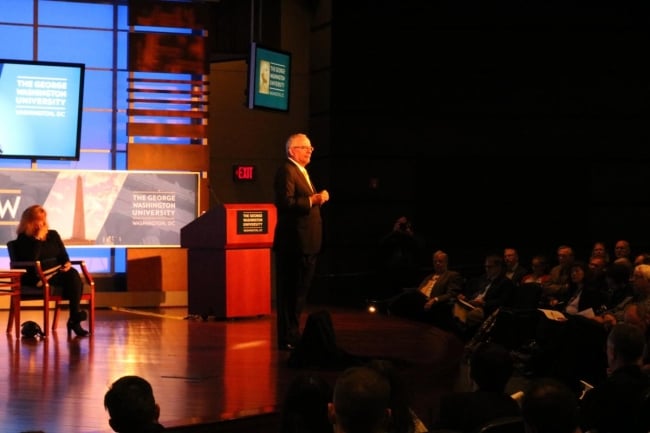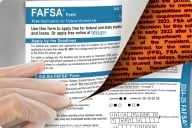You have /5 articles left.
Sign up for a free account or log in.

George Washington president Thomas LeBlanc
Credit Greta Anderson
George Washington University faculty members are unhappy about being left out of the process that led to a plan to reduce undergraduate enrollment. They are determined to learn more about how university administrators arrived at the decision in which faculty members say they had little to no input.
Thomas LeBlanc, the university's president, announced in July that the university would move to decrease the undergraduate population and increase the number of students majoring in STEM subjects. The move surprised and concerned many faculty members, who publicly questioned the wisdom and long-term implications of such a far-reaching decision.
More than 200 faculty members attended an unusually crowded faculty assembly last week to discuss their continuing efforts to learn more about the planned 20 percent cut from the undergraduate population and 11 percent increase in STEM majors by 2024. There was nearly unanimous agreement for the Faculty Senate to dig deeper into the methods that determined the enrollment shifts as part of the university's five-year strategic plan.
The plan aims to address GW's academic shortcomings -- the university lags behinds most other private research institutions in STEM education -- and to improve the student experience on campus, which LeBlanc said has suffered in the last five years due to overstretched facilities, high faculty-to-student ratios and overcrowded classrooms. Part of the long-term goal of the plan is to bring the total number of students studying STEM disciplines to 30 percent; the current rate is 19 percent.
But when both initiatives are paired together, the university’s plan to significantly increase STEM students is not reached, said Harald Griesshammer, a physics professor and a member of the Faculty Senate's educational policy committee. The $64 million budget deficit predicted by the university as a result of the enrollment cut would also decrease the number of non-Asian students of color and those from low-income backgrounds at the university.
“All these changes don’t come for free, and we need to understand what the consequences of the changes are,” Griesshammer told the gathered faculty members. “We do not have the numbers to really discuss those changes with qualified information. We need that information.”
Griesshammer said he is happy over all with the goal to better the university's STEM programs, which he agrees needs improvement. LeBlanc noted that engineering and the sciences have faced “historic underinvestment” at the university for more than 175 years.
Griesshammer said although he's happy university's leaders want to improve and increase STEM programs, he's concerned that the push for more STEM majors may end up costing the university more than it can afford. It may also shortchange non-STEM majors; GW students who study STEM-related fields receive a higher average tuition discount of 51 percent in an effort to get them to attend the university, while others receive a discount of 42 percent, according to Faculty Senate documents, whose data was confirmed by LeBlanc.
“I’m worried because if I get more students and the quality of those students is not good, then I have not profited from a move to go to more STEM students,” Griesshammer said. “If I have a budget hole, I’m not going to have the resources to help those students. We would have to do more with less.”
Faculty members had hoped the meeting would be an opportunity for LeBlanc to address their concerns about budgetary constraints their various departments may face as a result of the enrollment cut and STEM focus, said Bernard Wood, a professor in the department of anthropology. Instead, Wood said LeBlanc “lectured” faculty members rather than participating in a discussion of what the plan will mean for the university’s future.
During the meeting, LeBlanc shared anecdotes from town hall meetings with students, in which they shared a desire for more STEM education at GW in order to be more competitive in the job market. But Wood said he had heard all the stories before, and faculty members in the audience repeatedly shook their heads when LeBlanc returned to these stories.
“He does not enjoy the confidence of the faculty,” Wood said, echoing points made by others. Wood has worked at GW for 21 years and is a member of the GWU Faculty Association, a separate body formed by faculty members who felt inadequately represented by the Faculty Senate.
Members of the audience applauded after Wood told LeBlanc he lost the opportunity to engage in a substantive discussion with faculty members by repeating the same talking points he'd used when the strategic plan was announced.
"I am absolutely convinced that this is not the challenge it looks like," LeBlanc told the gathering.
The Faculty Senate and its various committees will pursue more information about the potential impact of the strategic plan as a result of a petition faculty members started this month, said Sylvia Marotta-Walters, chair of the Faculty Senate’s executive committee. Results of the committees’ investigations will be shared publicly in Faculty Senate meeting minutes by the end of December, according to the petition. In response to faculty members' questions about whether the strategic plan involved shared governance, Marotta-Walters assured them that executive committee members had discussions with the administration before LeBlanc announced the plan in July, but faculty members said they want direct communication with administrators.
LeBlanc told the gathering that data on the expected outcomes of the strategic plan is available upon request from Strategic Planning Task Force committees created by the university. He emphasized that the university is working with the committees to determine the best path to achieve the goals of the plan, which he said is subject to change.
"The committees are going to have all the information they want. We’ve told all the committee chairs, whatever you want,” LeBlanc said. “What we didn’t do is say, ‘here’s the right answer,’ because that shouldn’t be our call. The faculty and the faculty committees ought to be involved in those decisions.”
But it’s unclear to faculty members, even those who sit on the committees, whether funds will be cut from academic departments to compensate for the loss in tuition over five years, said Katrin Schultheiss, chair of the history department and a member of the High-Quality Undergraduate Education Committee. She said the various committees are tasked with coming up with recommendations without knowing precisely how the university’s budget will be affected. For them, the 20 percent enrollment cut is top of mind.
“There’s a mismatch there if you have faculty-dominated groups proposing various changes without any budgetary knowledge, and you have a different group determining budgetary changes without knowing the restraints,” Schultheiss said.
The STEM focus also concerns departments that have upheld the university’s reputation as a premier D.C.-based institution focused on public policy, journalism and law. Faculty members from these departments believe they may face unique budgetary constraints with the influx of more STEM students, Schultheiss said.
LeBlanc has tried to reassure faculty members that he doesn't intend to damage what has defined George Washington since its founding. The increase in STEM undergraduate enrollment will include current students who pursue second STEM-related majors and will not rely entirely on new students to reach the 30 percent benchmark, he explained.
Faculty members are not convinced. If the plan is to decrease undergraduate enrollment by one-fifth and increase STEM majors by more than one-tenth of the student population, the inevitable result would be a decrease in undergraduates in non-STEM departments, Schultheiss said.
“I don’t see how that math comes out,” Schultheiss said. “Not that there’s a concerted effort to cut back on the humanities, but if you reduce resources, then increase STEM students, there will be fewer students in other fields and fewer faculty resources.”
Schultheiss is not sure a strict STEM emphasis is best for the university. She noted that Georgetown University, the other private research institution in Washington, has a comparable number of students enrolled in STEM majors.
“It’s natural that the focus wouldn’t be on STEM in D.C.,” she said. “Having a strong STEM program has to be central to any major research university. I don’t think that you would find a single humanities person on campus who doesn’t back strong STEM. The problem is what appears to be arbitrary goals and no apparent thought on how to get there.”








